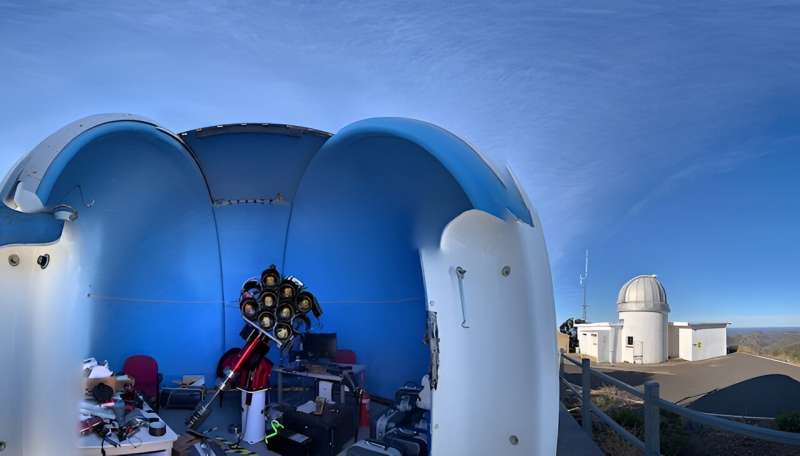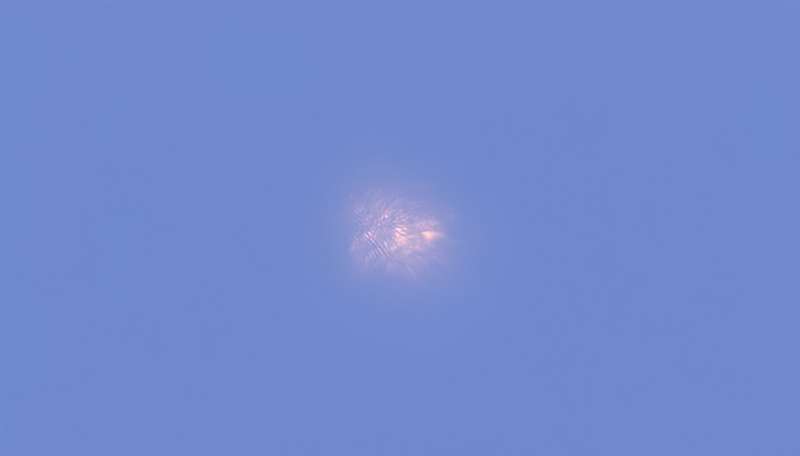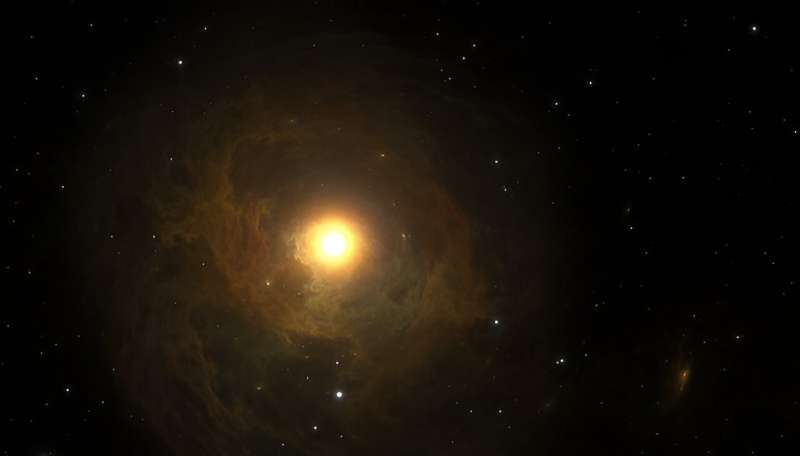This article has been reviewed according to Science X's editorial process and policies. Editors have highlighted the following attributes while ensuring the content's credibility:
fact-checked
trusted source
proofread
Stargazing in broad daylight: How a multi-lens telescope is changing astronomy

Astronomers at Macquarie University have pioneered a new technique for observing celestial objects during the day, potentially allowing around-the-clock visual monitoring of satellites and greatly improving safety on Earth and in space.
Their technique uses the University's Huntsman Telescope, a unique array of 10 camera lenses working in parallel, originally designed for ultra-sensitive night sky observations.
In a paper published in Publications of the Astronomical Society of Australia on 20 May, the researchers demonstrate the Huntsman's ability to accurately measure stars, satellites and other targets when the sun is high overhead, despite astronomers traditionally only observing at night.
"People have tried observing stars and satellites in optical wavelengths during the day for centuries, but it has been very difficult to do. Our tests show the Huntsman can achieve remarkable results in daylight hours," says lead author and astrophysics Ph.D. candidate Sarah Caddy, who helped design and build the Huntsman Telescope.
Caddy worked with a team of Ph.D. students and staff at Macquarie to deploy the Huntsman, which celebrated its official opening at Siding Springs Observatory in Coonabarabran last year.
The telescope combines an astronomy camera and astro-mechanical focusing equipment with an array of 10 highly sensitive 400mm Canon lenses, oriented to cover the same patch of sky.
Because the sun floods out most light from other celestial objects, astronomers rarely observe during the day, but Caddy and her colleagues trialed special "broadband" filters on a test version of the Huntsman telescope to block most daylight while still allowing specific wavelengths from celestial objects to pass through.
This test version, a mini-Huntsman single-lens pathfinder telescope installed at the University's observatory, allowed the research team to assess various settings in a controlled environment without affecting the Huntsman telescope.
Supernova approaching
The Huntsman's daytime capability allows continual monitoring of certain bright stars that can be unobservable at night for months at a time because they are too close to the sun.
One example is the red supergiant Betelgeuse, a nearby star around 650 light-years away in the Orion constellation in our Milky Way galaxy.
Betelgeuse is of great interest to astronomers since the star dimmed substantially from late 2019 through 2020, likely due to a major ejection of gas and dust.

"Without this daytime mode, we'd have no idea if one of the brightest stars in the sky has gone supernova until a few months after its explosive light reached Earth," says co-author Associate Professor Lee Spitler, Head of Space Projects at Macquarie's Australian Astronomical Optics (AAO).
"We know Betelgeuse will blow up 'soon' [in astronomical terms this means anytime between now and millions of years into the future], but not exactly when it will happen.
"For about four months of the year, it's only observable during the daytime because the sun gets between Betelgeuse and the Earth at this time."
Calibrating with Betelgeuse
The study confirmed the Huntsman's daytime photometry data for Betelgeuse tallies with observations from observatories around the world, and even with space telescopes.
"This breakthrough paves the way for uninterrupted, long-term studies of stars like Betelgeuse as they undergo powerful eruptions near their end of life, expelling massive amounts of stellar material in the final stages of the cosmic cycle of rebirth," says Spitler.
"Astronomers love when stars in the Milky Way go supernova because it can tell us so much about how elements are created in the universe."
Unfortunately, he adds, supernova in the Milky Way are relatively rare—the last time it happened was in 1604.
"But when a supernova went off in a mini-galaxy next to our Milky Way galaxy in 1987, this was so useful for astronomers that they still observe the expanding supernova explosion almost 40 years later."
Preventing collisions
Mastering daytime observation also delivers a big advantage in the rapidly expanding field of space situational awareness (SSA), which is the close monitoring of an ever-growing population of satellites, space debris and other artificial objects orbiting Earth.
More satellites will be launched in the next 10 years than in the entire history of human space exploration.

"With around 10,000 active satellites already circulating the planet and plans to launch a further 50,000 low Earth orbit satellites in the next decade, there's a clear need for dedicated day and night telescope networks to continually detect and track satellites," says Caddy.
Potential satellite collisions have grave implications for communications, GPS, weather monitoring and other critical infrastructure.
Satellite photometry—an astronomy technique using optical telescopes to study changes in the brightness of celestial objects—can reveal valuable information, including the composition, age and condition of orbiting objects.
"Opening up to daytime observation of satellites allows us to monitor not just where they are, but also their orientation, and adds to the information we get from radar and other monitoring methods, protecting against potential collisions," Caddy says.
Astro treats
Caddy's team demonstrated the Huntsman's potential for other astronomy observations requiring day and night coverage, including monitoring satellites.
The team used the mini-Huntsman to refine techniques over many months, systematically investigating such factors as optimal exposure times, observation timing and precise tracking of targets even through atmospheric turbulence.
"Daytime astronomy is an exciting field, and with advances in camera sensors, filters and other technologies, we saw dramatic improvements in the sensitivity and precision achievable under bright-sky conditions," says Caddy.
Adds Spitler, "We've refined a methodology for daytime observing and demonstrated it can be done on affordable, high-end equipment like the Canon lenses."
The Huntsman has been constructed so the 10 lenses work in parallel, feeding 10 ultra-fast CMOS camera sensors that together can take thousands of short-exposure images per second.
The attached camera can process images and manage very large data streams in an instant, using robotic control to track and capture fast-moving objects, and delivering continuous 24-hour monitoring of objects.
"Being able to do accurate, round-the-clock observations shatters longstanding restrictions on when astronomers can scan the heavens," says Spitler.
"Daytime astronomy will be increasingly critical as we enter the next Space Age."
More information: Sarah E. Caddy et al, An Optical Daytime Astronomy Pathfinder for the Huntsman Telescope, Publications of the Astronomical Society of Australia (2024). DOI: 10.1017/pasa.2024.43
Provided by Macquarie University
This content was originally published on The Macquarie University Lighthouse.





















